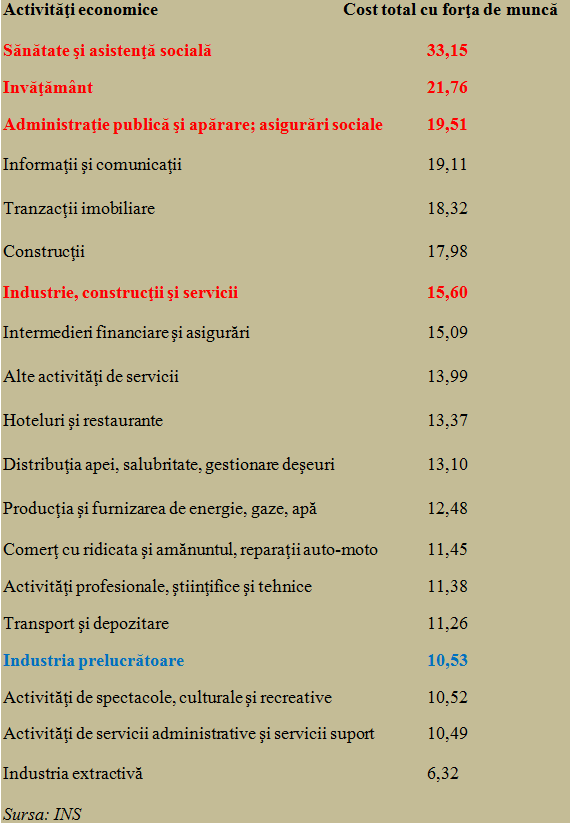 Hourly labour cost increased by 15.6% in the second quarter of 2018 compared to the same period of 2017 (+ 9.36%, compared to Q1 2018), according to data announced by INS.
Hourly labour cost increased by 15.6% in the second quarter of 2018 compared to the same period of 2017 (+ 9.36%, compared to Q1 2018), according to data announced by INS.
It is a higher and increasing pace compared to previous quarters (12.72% in Q1 2018 and 14.29% in Q4 2017), with the top position being held by the public sector, while the manufacturing industry ranks last among the activities of the national economy.
According to latest data processed by Eurostat, in the first quarter of 2018, Romania already ranked second within the EU, in terms of labour unitary cost increase, with 145.8%. This indicator is defined as the ratio between labour costs and labour productivity, assessed by a unitary European methodology applied across all EU member states.
The reference is 2010, at the level of 100%. For the correct positioning, we mention that Bulgaria ranked first (155.5%) and Baltic countries (Latvia with 142.1%, Estonia with 136.1%, and Lithuania with 133.4%) and Hungary (130, 0%) were behind us. The Czech Republic (119.7%), Slovakia (115.3%) and Poland (111.8%) registered much lower values.
Some of these rhythms are due to the low starting level for labour remuneration, but we should keep in mind not to force a too rapid rise compared to productivity growth.
However, the results of the first half of the current year are not encouraging, since the advance of this indicator (calculated for the manufacturing industry, according to usages) was half that of the previous year.
*
- Labour productivity in manufacturing industry
- Year
- Labour productivity
*
While at the end of last year the increase in labour cost was approximately double the GDP growth rate (estimated at 6.9%), in Q2 2018 it has been reached to an almost four times higher ratio in the context of a slowdown in the economic growth to just four percentage points.
The major mismatch between the two indicators already raises questions.
By field of activity, we can notice substantial differences in salary increases.
Specifically the public sector (where the assessment of labour productivity is the most questionable, but sets the labour market trend) has moved to the forefront of the economy and has pushed the average to over 15%, although the manufacturing industry has remained somewhere slightly above 10%, along with the entertainment, cultural and recreational activities.
Labour cost increase by sectors
This is how much labour cost has increased in different sectors of the economy, structured according to international norms:
*
- Economic activities total labour cost
- Health and social assistance
- Education
- Public administration and defence; social insurance
- IT & C
- Real estate
- Construction
- Manufacturing, construction and services
- Financial intermediations and insurance
- Other service activities
- Hotels and restaurants
- Water supply, sewerage, waste management
- Energy, gas and water production and supply
- Wholesale and retail trade, auto repairs
- Professional, scientific and technical activities
- Transport and storage
- Manufacturing industry
- Entertainment, cultural and recreational activities
- Administrative and support service activities
- Extractive industry
*
The bizarre distribution of salary cost increases in the economy, with those who are paid from taxes collected being positioned ahead of other employees, will become less and less sustainable.
The process of collecting money to the public budget already faces difficulties in keeping the pace with the rhythm of salary and pension increases, which have received a new increase by 10% in the middle of the year.
We remind that double-digit growth in revenues is rare in a settled economy. The share of wages in the cost of products has already contributed to an advance of over six percentage points in industrial production prices.
This advance is increasingly difficult to align within the trade chain and will inevitably, to a greater or lesser extent, be seen inflation.











